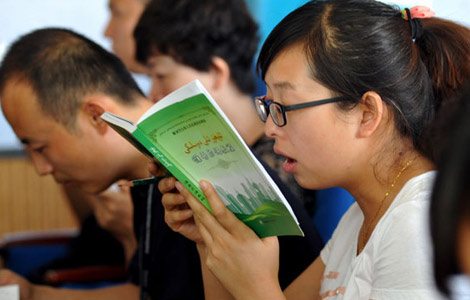China helps out energy-starved Pakistan
Updated: 2013-08-08 07:52
By Zhang Yunbi (China Daily)
|
|||||||||||
Editor's note: China Daily continues its coverage from neighboring countries in an effort to provide insight into topics relevant to China. In the third part of our Pakistan series, we explore Chinese efforts to alleviate Pakistan's energy thirst and improve its infrastructure.
With an ongoing energy shortage affecting nearly every household in Pakistan, several Chinese power companies and institutes are working closely with the nation's government to take advantage of its natural resources and increase electricity production.
The Shanghai Marine Diesel Engine Research Institute recently agreed to help build a power plant in Pakistan to convert the byproduct of processing sugarcane into electricity. The goal is for the plant to provide an annual capacity of 960,000 mWh.
"The plant has the highest productivity among those of the same kind in the world," said Jin Donghan, head of the institute. "Pakistan is a country rich in sugarcane and turning that into electricity is a very cost-effective option for the country to find a way out of its shortage of energy."
According to a May report by The New York Times, lights go out for at least 10 hours a day in major cities in Pakistan and up to 22 hours a day in rural areas. Finding a solution to the nation's energy crisis topped Prime Minister Nawaz Sharif's agenda during his visit to China from July 3 to 8.
 |
|
Engineers of the Harbin Boiler Co test the steam generator developed for the Chashma Nuclear Power Plant in Pakistan. [Provided for China Daily] |
Chinese companies in Pakistan have also made strides to improve the nation's production in hydroelectricity.
Xiong Lixin, vice-president of Sinohydro Corp Ltd, served nearly seven years ago as a project manager for the landmark Gomal Zam Dam in northern Pakistan to help build both the dam and a hydroelectric plant at the site.
The dam also serves to help irrigate farmland and control flooding.
Designed and built by Power Construction Corp of China, the plant successfully connected to the national grid on June 26. Xiong said what impressed him most during his time in Pakistan was the intelligence and diligence of the Chinese staff who worked hard to meet construction deadlines on the dam.
With an installed capacity of 17,400 kW, the hydroelectric plant will provide energy to about 25,000 local households, while the dam will help the country avoid annual economic losses of $2.6 million due to flooding.
Xiong said the dam is a symbol of China's leading construction technologies. Pakistani people called the project their national version of the Three Gorges Dam, a mega hydropower generation project along the Yangtze River.
But in building power plants for the country, Chinese companies and contractors have faced numerous difficulties, including concerns about their security.
"The Chinese staff members were brave because the location of the plant was close to Afghanistan and relatively dangerous. That intimidated many other foreign engineers," Xiong said.
In October 2004, work on the dam came to a halt after unidentified militants kidnapped two Chinese engineers working on the project at the northwestern border of Pakistan.
Today's Top News
Exports, spending 'to ebb'
Dairy firms hit with fines
Obama cancels meeting with Putin
Sino-US trade gap narrows
A stage set for big innovation
AT&T ready for disaster recovery
China helps out energy-starved Pakistan
Study reaffirms 'cancer villages'
Hot Topics
Lunar probe , China growth forecasts, Emission rules get tougher, China seen through 'colored lens', International board,
Editor's Picks

|

|

|

|

|

|





